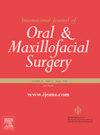对 32 名幼年特发性关节炎患者进行包括牵引成骨术在内的颌骨矫正手术的长期随访。
IF 2.2
3区 医学
Q2 DENTISTRY, ORAL SURGERY & MEDICINE
International journal of oral and maxillofacial surgery
Pub Date : 2025-02-01
DOI:10.1016/j.ijom.2024.06.001
引用次数: 0
摘要
幼年特发性关节炎(JIA)累及颞下颌关节(TMJ)后出现的牙颌面畸形与功能、美观和社会心理障碍有关。矫正手术治疗包括正颌手术(OS)组合。本研究旨在评估包括下颌牵引成骨术(MDO)在内的正颌外科手术后的口面部症状、功能和美学状况以及稳定性。研究人员对2003年至2018年期间接受MDO作为唯一手术或与双侧矢状劈开截骨术、Le Fort I和/或genioplasty联合手术的32名颞下颌关节关节炎和牙颌面畸形患者进行了前瞻性研究。分析了术前、术后和长期(平均 4 年)的临床检查和头颅影像数据。患者的口面部症状无变化(均 P > 0.05),短期颞下颌关节功能障碍(均 P本文章由计算机程序翻译,如有差异,请以英文原文为准。
Long-term follow-up of corrective jaw surgery including distraction osteogenesis in 32 patients with juvenile idiopathic arthritis
Dentofacial deformity following juvenile idiopathic arthritis (JIA) with temporomandibular joint (TMJ) involvement is associated with functional, aesthetic, and psychosocial impairment. Corrective surgical treatment includes combinations of orthognathic surgeries (OS). The aims of this study were to assess orofacial symptoms, functional and aesthetic status, and stability after OS including mandibular distraction osteogenesis (MDO). A prospective study was conducted of 32 patients with JIA of the TMJ and dentofacial deformities who underwent MDO as the only surgery or in combination with bilateral sagittal split osteotomy, Le Fort I, and/or genioplastybetween 2003 and 2018. Data from clinical examinations and cephalograms performed pre- and postoperative and at long-term (mean 4 years) were analysed. Patients experienced unchanged orofacial symptoms (all P > 0.05), short-term TMJ functional impairment (all P < 0.001), and long-term morphological improvements in SNB angle (P < 0.001), anterior facial height (P < 0.001), mandibular length (P = 0.049), overjet (P < 0.001 and P = 0.005), and posterior facial symmetry (P = 0.046). MDO as the only surgery or with secondary adjunctive OS improved dentofacial morphology in terms of mandibular advancement, anterior facial height, posterior facial symmetry, and incisal relationships without long-term deterioration in TMJ function or orofacial symptoms.
求助全文
通过发布文献求助,成功后即可免费获取论文全文。
去求助
来源期刊
CiteScore
5.10
自引率
4.20%
发文量
318
审稿时长
78 days
期刊介绍:
The International Journal of Oral & Maxillofacial Surgery is one of the leading journals in oral and maxillofacial surgery in the world. The Journal publishes papers of the highest scientific merit and widest possible scope on work in oral and maxillofacial surgery and supporting specialties.
The Journal is divided into sections, ensuring every aspect of oral and maxillofacial surgery is covered fully through a range of invited review articles, leading clinical and research articles, technical notes, abstracts, case reports and others. The sections include:
• Congenital and craniofacial deformities
• Orthognathic Surgery/Aesthetic facial surgery
• Trauma
• TMJ disorders
• Head and neck oncology
• Reconstructive surgery
• Implantology/Dentoalveolar surgery
• Clinical Pathology
• Oral Medicine
• Research and emerging technologies.

 求助内容:
求助内容: 应助结果提醒方式:
应助结果提醒方式:


